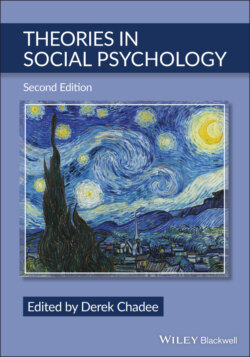Читать книгу Theories in Social Psychology - Группа авторов - Страница 9
References
Оглавление1 Adams, J. S. (1965). Inequity in social exchange. In L. Berkowitz (Ed.), Advances in experimental social psychology (Vol. 12, pp. 267–300). Academic Press.
2 Allport, F. H. (1924). Social psychology. Houghton Mifflin.
3 Allport, G. (1968). The historical background of modern social psychology. In G. Lindzey & E. Aronson (Eds.), The handbook of social psychology (Vol. 1). Addison-Wesley.
4 Aronson, E. (1968). Dissonance theory: Progress and problems. In R. P. Abelson, E. Aronson, W. J. McGuire, T. M. Newcomb, M. J. Rosenberg, & P. H. Tannenbaum (Eds.), Theories of cognitive consistency: A source book (pp. 5–27). Rand McNally.
5 Aronson, E. (2007). The evolution of cognitive dissonance theory. In A. R. Pratkanis (Ed.), The science of social influence: Advances and future progress (pp. 115–135). Psychology Press.
6 Bem, D. J. (1967). Self-perception: An alternative interpretation of cognitive dissonance phenomena. Psychological Review, 74 (3), 183–200. https://doi.org/10.1037/h0024835
7 Deutsch, M. (1985). Distributive justice: A social-psychological perspective. Yale University Press.
8 Dubin, R. (1978). Theory development. New York: Free Press.
9 Festinger, L. (1957). A theory of cognitive dissonance. Stanford University Press.
10 Festinger, L., & Carlsmith, J. M. (1959). Cognitive consequences of forced compliance. Journal of Abnormal and Social Psychology, 58 (2), 203–210. https://doi.org/10.1037/h0041593
11 Gioia, D. A., & Pitre, E. (1990). Multiparadigm perspective on theory building. The Academy of Management Review, 15 (4), 584–602. https://doi.org/10.2307/258683
12 Harmon-Jones, E., Harmon-Jones, C., & Levy, N. (2015). An action-based model of cognitive dissonance processes. Current Directions in Psychological Science, 24 (3), 184–189. https://doi.org/10.1177/0963721414566449
13 Heider, F. (1958). The psychology of interpersonal relations. Wiley.
14 Jones, E. E., & Davis, K. E. (1965). From acts to dispositions: The attribution process in person perception. In L. Berkowitz (Ed.), Advances in experimental social psychology (Vol. 2, pp. 219–266). Academic Press.
15 Kelley, H. H. (1967). Attribution theory in social psychology. In D. Levine (Ed.), Nebraska symposium on motivation (Vol. 15, pp. 192–238). University of Nebraska Press.
16 Kuhn, T. S. (1996). The structure of scientific revolutions (3rd ed.). University of Chicago Press.
17 Lakatos, I. (1970). Falsification and the Methodology of Scientific Research Programmes. In I. Lakatos & A. Musgrave (Eds.), Criticism and the growth of knowledge. Cambridge University Press.
18 Lynham S. A. (2000). The development of a theory of responsible leadership for performance. (Tech. Rep.). St. Paul: University of Minnesota, Human Resource Development Research Center.
19 Malle, B. F. (1999). How people explain behavior: A new theoretical framework. Personality and Social Psychology Review, 3 (1), 23–48. https://doi.org/10.1207/s15327957pspr0301_2
20 Malle, B. F. (2004). How the mind explains behavior: Folk explanations, meaning, and social interaction. MIT Press.
21 McDougall, W. (1908). Introduction to social psychology. Methuen.
22 Morgeson, F. P., & Hofmann, D. (1999). The structure and function of collective constructs: Implications for multilevel research and theory development. The Academy of Management Review, 24 (2), 249. https://doi.org/10.2307/259081
23 Petty, R. E., & Cacioppo, J. T. (1986). The elaboration likelihood model of persuasion. In L. Berkowitz (Ed.), Advances in experimental social psychology (Vol. 19, pp. 123–205). Academic Press.
24 Popper, K. R. (1965). Conjectures and refutations: The growth of scientific knowledge. Harper Torchbooks.
25 Popper, Κ. R. (1982). Unended quest: An intellectua/ autobiography. Open Court.
26 Ross, E. A. (1908). Social psychology. Macmillan.
27 Sprecher, S., & Schwartz, P. (1994). Equity and balance in the exchange of contributions in close relationships. In M. L. Lerner & G. Mikula (Eds.), Entitlement and the affectional bond: Justice in close relationship (pp. 11–41). Plenum.
28 Steele, C. M. (1988). The psychology of self-affirmation: Sustaining the integrity of the self. In L. Berkowitz (Ed.), Advances in experimental social psychology (Vol. 21, pp. 261–302). Academic Press.
29 Tajfel, H. (1978). Interindividual behaviour and intergroup behaviour. In H. Tajfel (Ed.), Differentiation between social groups: Studies in the social psychology of intergroup relations (pp. 28–60). Academic Press.
30 Tajfel, H., & Turner, J. C. (1979). An integrative theory of intergroup conflict. In W. G. Austin & S. Worchel (Eds.), The psychology of intergroup relations (pp. 33–48). Brooks/Cole.
31 Thibaut, J. W., & Kelley, H. H. (1959). The social psychology of groups. Transaction Books.
32 Tripodi, T., Fellin, P., & Meyer, H.J. (1969). The assessment of social research: Guidelines for use of research in social work and social science. Itasca, IL: F.E. Peacock.
33 Turner, J. C., Hogg, M. A., Oakes, P. J., Reicher, S. D., & Wetherell, M. S. (1987). Rediscovering the social group: A self-categorization theory. Blackwell.
34 Waltz, K. (1997). Evaluating theories Kenneth N. Waltz source. The American Political Science Review, 91 (4), 913–917. URL https://www.jstor.org/stable/2952173
